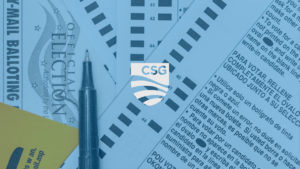
By Grace Harrison and Casandra Hockenberry
Free, fair and accessible elections are the cornerstone of a democratic society. But not all elections are created equal, and there is a large amount of variance in terms of election integrity globally. Election integrity isa concept “built on international commitments,” and, in the United States, is often based on aspects such as fairness to political parties and voters, competency of election administrators and security of the voting process and results.
In the U.S., elections are run by the states, resulting in procedural differences such as voter registration deadlines and voting processes. States ensure that elections are administered with integrity and security.
While the perception of election integrity has become an increasingly salient topic in recent years, equal and fair voting access and trust in election administration are basic components of U.S. elections.
Americans’ perception of electoral integrity is a multi-faceted concept. It consists of not only trust in elections but also in the electoral process and administration. The latter, governed by official rules and processes, is crucial for voters to understand. Election administration is highly decentralized, leaving the majority of key functions and responsibilities to officials at a county or municipality level.
The Professionalism of Election Administration
Election administration includes state chief election officers, state election directors, state election commissions and boards, and local election officials including town, city, and county clerks, boards, and an array of other election professionals. Though the exact process for appointing election officials and administrators varies by state statute, chief election officials are generally chosen across the U.S. in one of four ways: they are either elected by voters directly, appointed by the governor, elected by the legislature, or elected by the state board or commission of elections. In 37 states, this official serves as the Secretary of State. The National Conference of State Legislatures provides a detailed breakdown of state chief election officials, selection method and which states have a board or commission.
On a local level, elections are administered either by a single elected individual, board or commission, or a combination of these. These administrative units are responsible for the workings of election day, such as managing polling locations and the processing of ballots.
Election administration requires a high level of professionalism, and officials are aided by membership organizations that provide support through resources, forums for sharing best practices and innovative ideas, and a community of other officials. The National Association of Secretaries of State, the National Association of State Election Directors and the National Association of Election Officials all provide invaluable resources.
There are also certification programs for election officials. In partnership with Auburn University, The Election Center has a professional education program which offers certification as a Certified Elections or Registration Administrator. This certification requires the completion of continuing education credits to maintain active status. Officials can also seek training from national or state organizations, among other resources.
Election officials also regularly receive security updates and briefings from the U.S. Department of Homeland Security Cybersecurity and Infrastructure Security Agency, the FBI and the Office of the Director of National Intelligence. All chief election officials and state election directors, as well as many local election officials, hold federal security clearances to stay apprised of and prepared for ongoing international and national threats to the security of elections.
Assessing Voter Confidence in Elections
Understanding how Americans perceive election integrity is not as simple as asking a yes or no question. Surveys often blur the lines between impressions of election administration and the overall electoral process in the US. Scholars attempt to clarify confidence in elections by surveying based on the relationship between these two concepts and their connection to trust in the government overall.
As with many public opinion polls, confidence in the American electoral system fluctuates with changes in administration, economic conditions and general social discourse. Individuals are more likely to accept and place trust in election results that align with their chosen candidate’s victory. When asking the question “how confident are you that, across the country, the votes will be accurately cast and counted in this year’s election — very confident, somewhat confident, not too confident or not at all confident,” Gallup found that across the years of 2004-2008 and 2016-2022, an average of 63% of voters reported they were “very” or “somewhat” confident in the accuracy of election outcomes.
Underlying national confidence levels, Gallup revealed major partisan divides. In 2016, this gap was only 30 percentage points, and in 2018, Republicans’ confidence outweighed that of Democrats by eight percentage points. Currently, 45 percentage points separate how confident Republicans and Democrats are in election accuracy.
Charles Stewart, founder of the MIT Election Data and Science Lab, focuses article, “Trust in Elections,” on the narrow view of questions the public uses to evaluate electoral integrity — whether votes were recorded and reported accurately, and cast by eligible voters. Then how trust in elections relates to trust in the process and government more broadly.
“By the most common measures of voter confidence, Americans were more confident in the electoral machinery following the 2020 election than they were in 2016,” Stewart wrote. “The difference is they were more polarized over the question in 2020. This polarization was not fueled by evidence of the shortcomings of election administration, but by basic psychological factors, such as emotions and motivated reasoning.”
Ultimately the public perception is not based on evidence but instead following the ongoing decline of public trust in American institutions broadly. To counter this, Stewart posits that “[t]he notable trustworthiness of the system can be maintained for only so long without widespread trust among Americans across the political spectrum.”







